New Report Details Devastating Effects Of Mass Incarceration On The U.S.
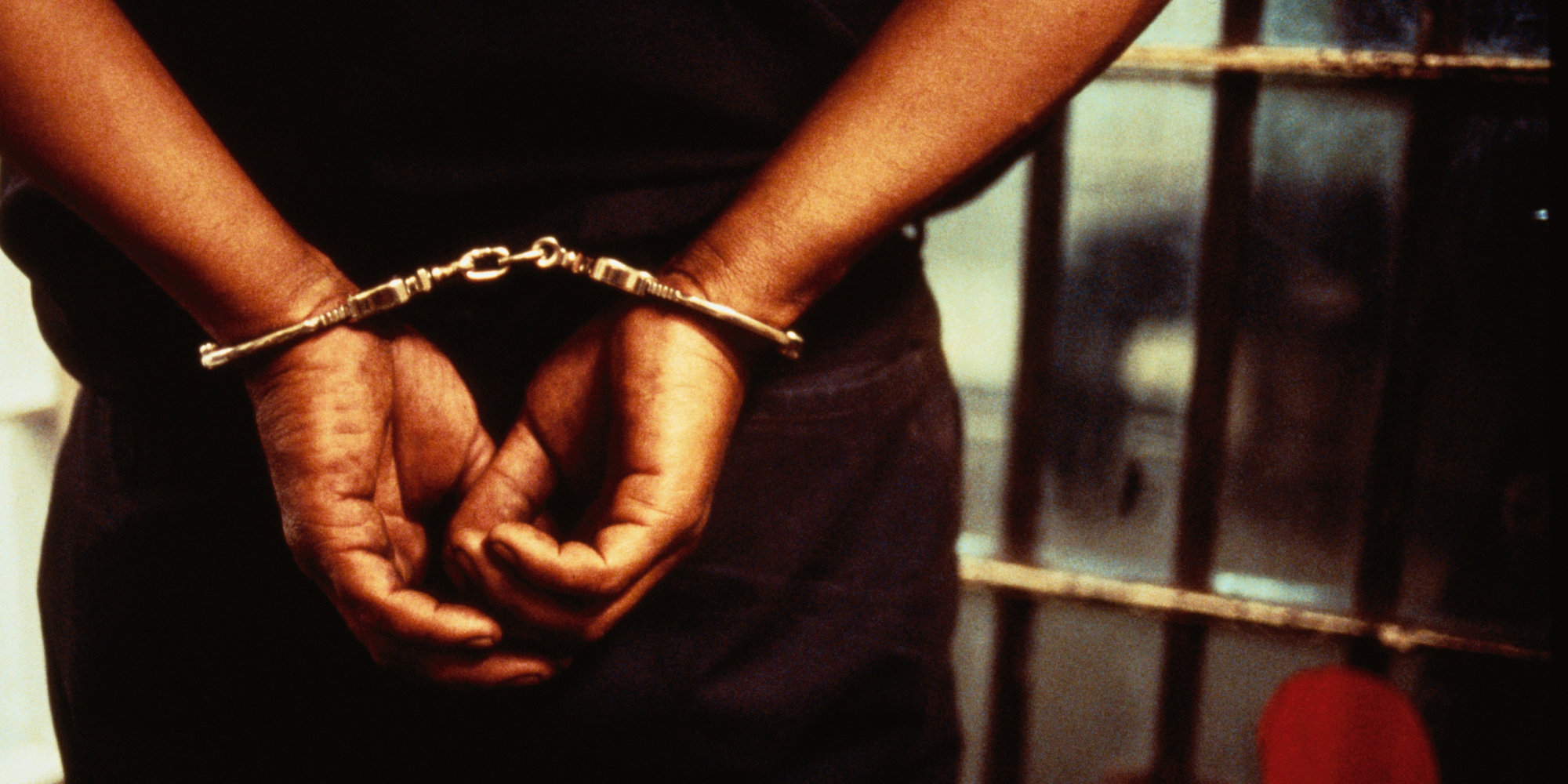
The American prison system is unlike any other in the world. It’s sprawling, expensive and largely ineffective at reducing crime or rehabilitating offenders. But in recent years, politicians and citizens alike have grown weary of the “tough on crime” policies that inflated the nation’s inmate population and made the U.S. the world’s leading jailer. Now they’re calling for reform.
A report released last week by the White House, titled “Economic Perspectives On Incarceration And The Criminal Justice System,” attempts to shed light on the scale of the catastrophe by looking at the issue through the lens of economics. It catalogues the startling financial and human costs of decades of bad policies, and proposes ways to correct course.
Here are some of the egregious issues the White House highlights in the report:
The World’s Top Jailer
The United States is home to just 5 percent of the world’s population, but it houses about 25 percent of the world’s prisoners. Today, there are roughly 2.2 million people behind bars in the United States in federal and state prisons or local jails. Harsh and lengthy sentences have helped to balloon that figure.
Adjusting for population, the report finds that the U.S. prison population grew 220 percent between 1980 and 2014 despite a dramatic reduction in crime rates during that same period — violent crime rates fell by 39 percent and property crimes fell by 52 percent.
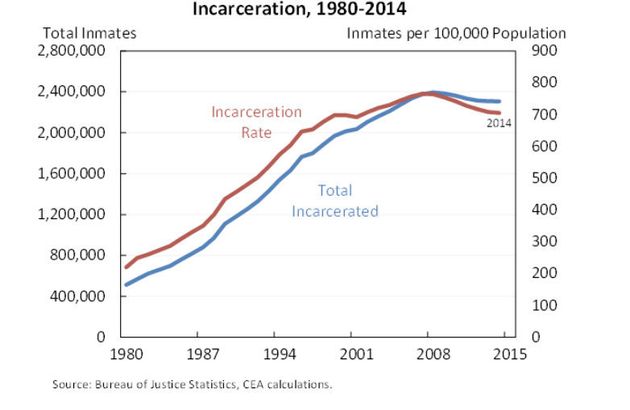
While it might be tempting to attribute declining crime rates to the effectiveness of incarceration, a large body of research indicates that this isn’t the case. Rather, the report cites a number of factors that have played a more significant role in reducing crime, including rising incomes and falling unemployment;changing demographics — particularly a decline in the number of young Americans, who are more prone to criminal behavior; improved police tactics; declines in alcohol consumption and crack use; as well as a reduction in exposure to lead.
So if crime rates were falling, what drove the wave of mass incarceration? Changes in sentences and enforcement, the researchers say, have led to longer prison terms and higher conviction rates for nearly all crimes.
The researchers note that changes in arrest patterns also likely have contributed to the incarceration boom. As crime rates have declined, arrests have too, but at a slower pace. This resulted in an increase in arrests per crime for both violent and property crime.
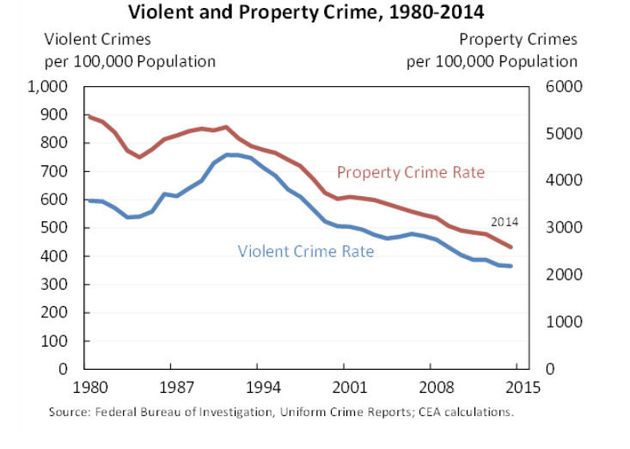
While arrests for various crimes were declining between 1980 and 2014, there was one exception: drug crimes, which ballooned a staggering 90 percent over that period. Arrests for drug crimes reached their peak in 2006, with law enforcement arresting 2 million people that year. Researchers say the trend has fallen in recent years, though it had longer-term effects on the increasing prison population.
Now, the majority of the nation’s incarcerated population (58 percent) is held in state prisons, one-third in local jails and about 9 percent in federal prisons. Even though the federal prison system holds the smallest percentage of inmates, its population grew the fastest between 1980 and 2014, increasing by 755 percent, according to the report.
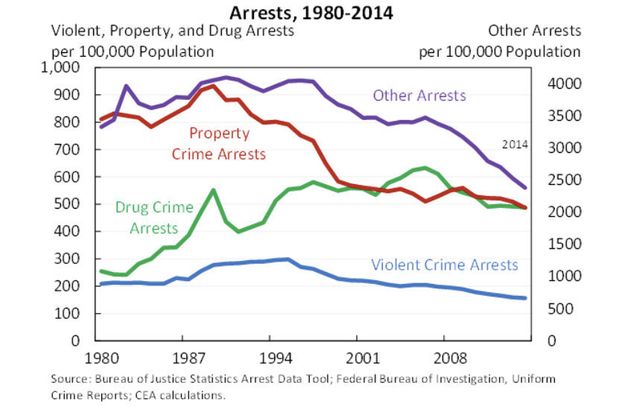
The Criminal Justice System’s Disproportionate Impact
The report cites a large body of research from multiple disciplines — economics, sociology, psychology and criminology — that has found that for similar offenses, blacks and Hispanics face a higher likelihood of arrest and conviction than whites, as well as harsher penalties. And even though blacks and Hispanics are no more likely to be found in possession of illegal goods, they are more likely to be stopped and searched by police — which in turn increases arrest rates.
Researchers also found that black defendants are 24 percent more likely to be convicted if their trial has a jury chosen from an all-white pool of jurors and that prosecutors are 75 percent more likely to charge black defendants with offenses that carry mandatory minimums. And if convicted, black defendants regularly receive longer sentences than whites for similar crimes. These trends mean minorities are more likely than white defendants to have an existing criminal record when they are charged with a new crime, which increases severity of punishment.
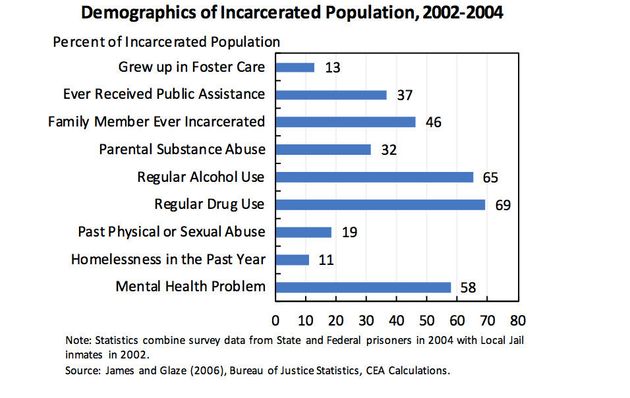
The failures of the criminal justice system also hit poor people and the vulnerable, as well as those suffering from mental illness or substance use disorders.
The report details several alarming statistics:
- Blacks and Hispanics make up about 30 percent of the U.S. population, but they compose over 50 percent of those incarcerated.
- Over one-third of the prison population has at some time received public assistance.
- One in 10 incarcerated persons was homeless in the year before they entered prison.
- Over 10 percent of those incarcerated have grown up in foster care.
- Nearly half of the prison population had a family member who was also incarcerated at some point.
- Almost 60 percent of people behind bars are mentally ill.
- Before being incarcerated, about 70 percent were regular drug users and 65 percent were regular alcohol users.
- About 65 percent of prisoners have not completed high school, and more than 10 percent have less than an 8th-grade education.
“Criminal justice sanctions can compound existing disadvantages for these populations, reinforcing patterns of intergenerational poverty,” the report reads.
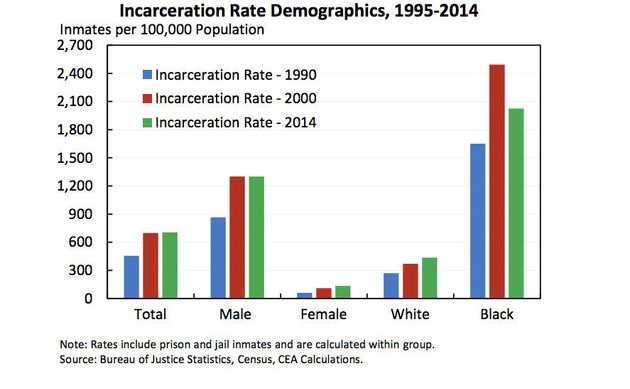
The Costs Are Enormous
Mass incarceration is extraordinarily costly. The U.S. spends $80 billion on incarceration each year and over $270 billion on the entire criminal justice system at the federal, state and local levels.
The United States employs 2.5 times more corrections officers per capita than other nations, but employs 30 percent fewer police officers per capita.
In 2013, 11 states spent more on incarcerating people than on higher education, the report notes.
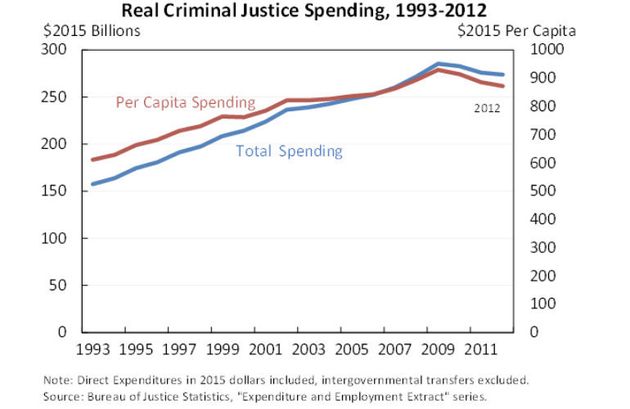
But that’s just the costs for local, state and federal governments. The researchers also called attention to indirect costs to the prisoners themselves, their families and their communities, all collateral damages that can last for generations.
There are roughly 70 million adult Americans — nearly a third of the entire adult population — with some kind of a criminal record. And about 5 million children have a parent who at some point has served time behind bars — with rates of parental incarceration at 2 to 7 times higher for black and Hispanic children than for white children.
After serving their time, ex-offenders face a myriad of challenges upon re-entering society.
A criminal record can keep ex-offenders from finding a job, not to mention one that is decent, safe and well-paying. Recent research has shown that job applicants with criminal records, who were otherwise identical to other applicants, were 50 percent less likely to get an interview or job offer. Those differences were even more pronounced for black applicants.
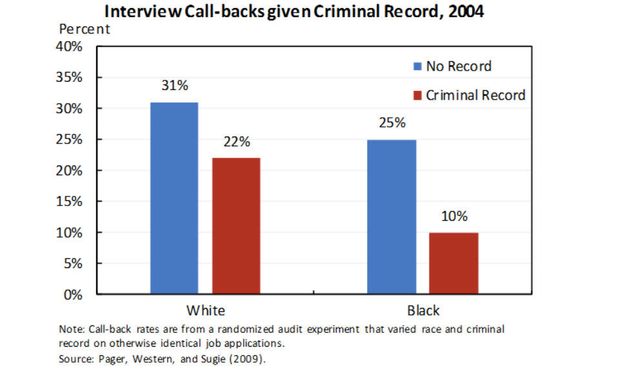
Incarceration Doesn’t Do What It’s Intended To Do
U.S. criminal justice policy is heavily reliant on incarceration, but researchers say that its effect on reducing crime can be marginal. Of course, putting someone behind bars can prevent some crime in the short term by removing that person from society at large, but according to research cited by the White House, incarceration’s effect on crime over the long term is one of diminishing returns.
The researchers note that while the prison population has seen massive expansion over recent decades, studies have shown that the impact of incarceration on crime is “modest” and that it declines as the prison population grows larger and older. The threat of longer sentences doesn’t appear to deter potential youth offenders either. Researchers found that juvenile arrest rates “barely respond” to lengthier expected sentences — a 10 percent increase in average sentence length produced a decrease in arrest rates of 0 to 0.5 percent.
And when a large population is behind bars, incarcerating more people likely entails jailing offenders who are on average lower-risk, meaning their incarceration will yield even fewer benefits to the public.
“[G]iven the size of the U.S. incarcerated population, the aggregate crime-reducing impact of increasing incarceration rates is likely to be minimal,” the report reads.
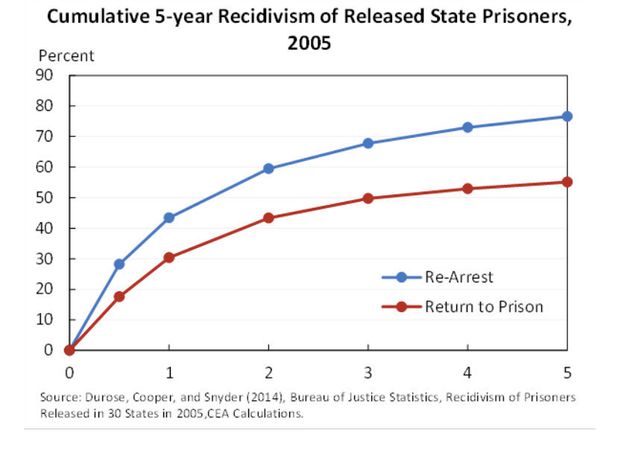
The U.S. releases about 600,000 prisoners each year. About two-thirds are arrested for a new crime within three years, and more than 75 percent are arrested within five years. The majority of these men and women are emerging from their cells unable to overcome the structural hurdles that have made it difficult to readjust into free society. The White House researchers say the American criminal justice system’s reliance on incarceration, especially longer sentences, may be significant part of that problem.
A growing body of research has shown that while incarceration may initially prevent crime, the more years a person serves, the more likely they are to engage in criminal activity upon release. The rate of recidivism increases for each additional year behind bars. Juvenile detention was shown to have similar effects on young offenders, increasing their likelihood of committing new crimes upon release and reducing their probability of earning a high school degree.
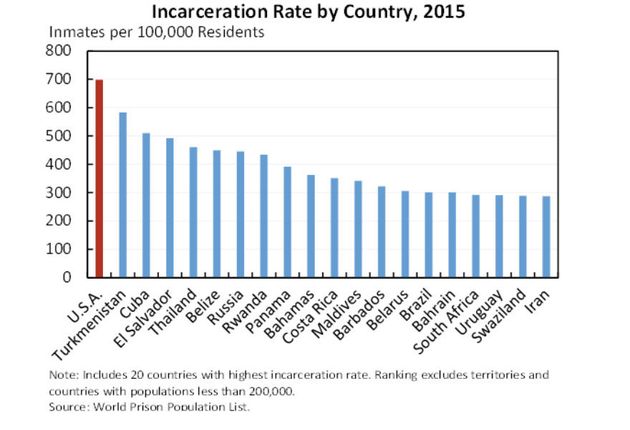
Correcting Course
The researchers looked at various alternative policies through the lens of economics, testing three potential areas of investment: increasing the prison population, expanding the police force and increasing the minimum wage to $12 per hour by 2020. Researchers found that increasing the minimum wage would produce significant benefits, as well as a reduction in crime rates. Increasing spending on policing by about 8 percent annually would produce high societal benefits and reductions in crime, they estimated, while investing an additional 12 percent in incarceration yielded the least benefits as well as the least reduction in crime rates.
A more cost-effective and beneficial criminal justice system is possible, the researchers argue, but it would require a more humane and holistic approach.
Read more: http://www.huffingtonpost.com/2016/05/02/effects-mass-incarceration_n_9825206.html